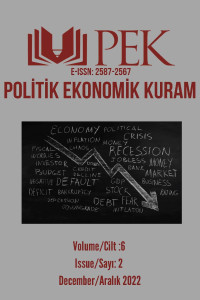Öz
Bu çalışmanın odağı John Rawls ve Robert Nozick tarafından geliştirilen adalet teorileri çerçevesinde adalet ve özgürlük kavramları arasındaki bağdır. Rawls ve Nozick adalete dair sorulara birbirinden oldukça farklı cevaplar vermişlerdir. Rawls geliştirdiği analiz araçlarıyla iki temel adalet ilkesine erişir. Bu ilkeler eşit temel özgürlükleri savunur ve bunların korunması için bazı gereklilikler getirir. Nozick ise adalete dair üç ilkeden bahseder. Bu ilkeler adil edinimi ve adil olmayan bir edinimden kaynaklanan adaletsizliğin giderilmesini içerir. Nozick bir şeyin elde edilmesinin adil bir sürecin sonunda olup olmadığına odaklanmış, toplumdaki bireylerin eşit özgürlüğünü ve bu eşit özgürlüğün korunması fikrini adalete dahil etmemiştir. İki düşünürün adalet teorilerinin birbirinden tamamen farklı yollarda ilerliyor olması da bununla ilgilidir. Taraflar apayrı özgürlük anlayışlarına sahiptir. Eşit temel özgürlükleri adaletin bir gereği olarak kabul eden Rawls, adil bir toplum için devlete eşit temel özgürlükleri koruma görevini yüklemiş ve pozitif özgürlükleri dikkate almıştır. Nozick ise minimal devleti savunmuş ve negatif özgürlüklerin bireylerin özgürlüğü için yeterli olduğunu düşünmüştür. Bu özgürlük anlayışları hakkaniyet olarak adalet ile yetkilenme teorisi arasındaki zıtlığın sebebidir. Bu zıtlık bizlere, adalet ve özgürlük kavramlarının birbirinden ayrı düşünülemeyecek, iç içe geçmiş ve birbirini belirleyen kavramlar olduğunu göstermektedir.
Anahtar Kelimeler
Hakkaniyet Olarak Adalet Yetkilenme Teorisi Özgürlük John Rawls Robert Nozick
Kaynakça
- Barry, B. (1973). The Liberal Theory of Justice: A Critical Examination of the Principal Doctrines in "A Theory of Justice" by John Rawls. London: Oxford University Press.
- Bercuson, J. (2014). John Rawls and the History of Political Thought. New York: Routledge.
- Buchanan, A. (1980). A Critical Introduction to Rawls' Theory of Justice. H. G. Blocker, & E. H. Smith içinde, John Rawls's Theory of Social Justices (s. 5- 41). Athens: Ohio University Press.
- Eren, A. A. (2008). Piyasa: Tarihi, Teorisi ve Eleştirileri (Doktora Tezi, Hacettepe Üniversitesi, Ankara).
- Freeman, S. (2018). Rawls on Distributive Justice and the Difference Principle. S. Olsaretti içinde, The Oxford Handbook of Distributive Justice (s. 1-31). Oxford: Oxford University Press.
- Kocaoğlu, M. (2017). John Rawls Adalet Teorisi ve Temel Kavramları. Ankara: İmaj Yayınevi.
- Kukathas, C., & Pettit, P. (1990). Rawls: A Theory of Justice and Its Critics. Stanford, California: Stanford University Press.
Öz
The focus of this essay is the link between the concepts of justice and freedom within the framework of the theories of justice developed by John Rawls and Robert Nozick. Rawls and Nozick have different answers for questions about justice. Rawls reaches two basic principles of justice with the analysis tools he developed. These principles uphold equal basic freedoms and impose certain requirements for their protection. Nozick talks about three principles about justice. These principles include fair acquisition and rectification of injustice resulting from an unfair acquisition. Nozick focused on whether the acquisition of something is at the end of a fair process, and did not include in justice the idea of equal freedom of individuals in society and the protection of this equal freedom. The fact that the theories of justice of the two thinkers proceed in completely different ways is also related to this. The parties have different understandings of freedom. Rawls, accepts equal basic freedoms as a requirement of justice, charged the state with the duty of protecting equal basic freedoms for a just society and took positive freedoms into acount. Nozick, on the other hand, defended the minimal state and thought that negative freedoms were sufficient for the freedom of individuals. These understandings of freedom are the cause of the contrast between justice as fairness and entitlement theory. This contrast shows us that the concepts of justice and freedom cannot be considered separately from each other, that they are intertwined and determine each other.
Anahtar Kelimeler
Hakkaniyet Olarak Adalet Yetkilenme Teorisi Özgürlük John Rawls Robert Nozick
Kaynakça
- Barry, B. (1973). The Liberal Theory of Justice: A Critical Examination of the Principal Doctrines in "A Theory of Justice" by John Rawls. London: Oxford University Press.
- Bercuson, J. (2014). John Rawls and the History of Political Thought. New York: Routledge.
- Buchanan, A. (1980). A Critical Introduction to Rawls' Theory of Justice. H. G. Blocker, & E. H. Smith içinde, John Rawls's Theory of Social Justices (s. 5- 41). Athens: Ohio University Press.
- Eren, A. A. (2008). Piyasa: Tarihi, Teorisi ve Eleştirileri (Doktora Tezi, Hacettepe Üniversitesi, Ankara).
- Freeman, S. (2018). Rawls on Distributive Justice and the Difference Principle. S. Olsaretti içinde, The Oxford Handbook of Distributive Justice (s. 1-31). Oxford: Oxford University Press.
- Kocaoğlu, M. (2017). John Rawls Adalet Teorisi ve Temel Kavramları. Ankara: İmaj Yayınevi.
- Kukathas, C., & Pettit, P. (1990). Rawls: A Theory of Justice and Its Critics. Stanford, California: Stanford University Press.
Ayrıntılar
| Birincil Dil | Türkçe |
|---|---|
| Bölüm | Makaleler |
| Yazarlar | |
| Yayımlanma Tarihi | 30 Aralık 2022 |
| Yayımlandığı Sayı | Yıl 2022 Cilt: 6 Sayı: 2 |
Bu eser Creative Commons Atıf-GayriTicari 4.0 Uluslararası Lisansı ile lisanslanmıştır.


